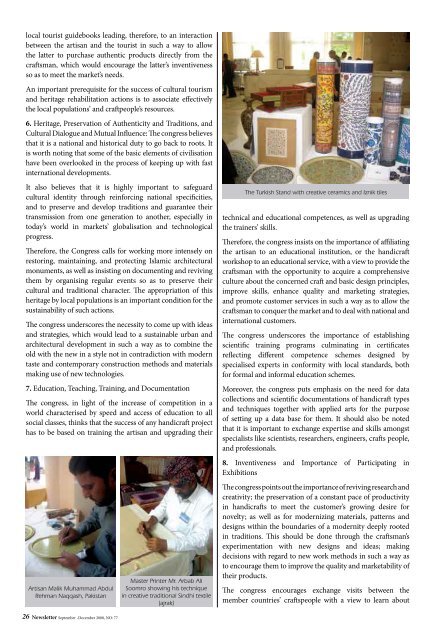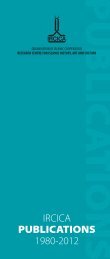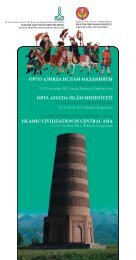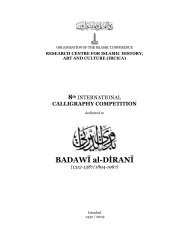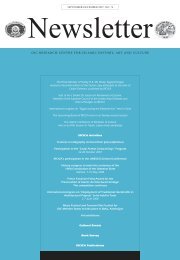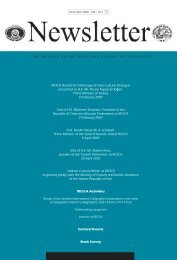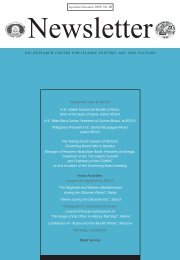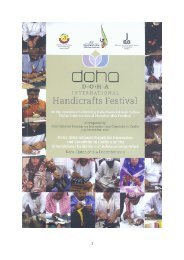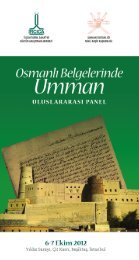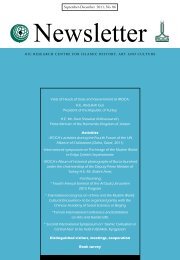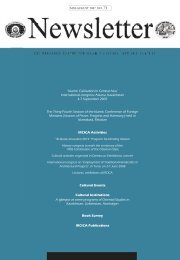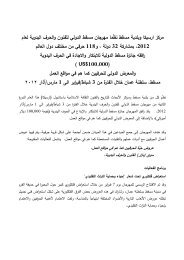IRCICA Newsletter Issue 77
IRCICA Newsletter Issue 77
IRCICA Newsletter Issue 77
- No tags were found...
Create successful ePaper yourself
Turn your PDF publications into a flip-book with our unique Google optimized e-Paper software.
local tourist guidebooks leading, therefore, to an interactionbetween the artisan and the tourist in such a way to allowthe latter to purchase authentic products directly from thecraftsman, which would encourage the latter’s inventivenessso as to meet the market’s needs.An important prerequisite for the success of cultural tourismand heritage rehabilitation actions is to associate effectivelythe local populations’ and craftpeople’s resources.6. Heritage, Preservation of Authenticity and Traditions, andCultural Dialogue and Mutual Influence: The congress believesthat it is a national and historical duty to go back to roots. Itis worth noting that some of the basic elements of civilisationhave been overlooked in the process of keeping up with fastinternational developments.It also believes that it is highly important to safeguardcultural identity through reinforcing national specificities,and to preserve and develop traditions and guarantee theirtransmission from one generation to another, especially intoday’s world in markets’ globalisation and technologicalprogress.Therefore, the Congress calls for working more intensely onrestoring, maintaining, and protecting Islamic architecturalmonuments, as well as insisting on documenting and revivingthem by organising regular events so as to preserve theircultural and traditional character. The appropriation of thisheritage by local populations is an important condition for thesustainability of such actions.The congress underscores the necessity to come up with ideasand strategies, which would lead to a sustainable urban andarchitectural development in such a way as to combine theold with the new in a style not in contradiction with moderntaste and contemporary construction methods and materialsmaking use of new technologies.7. Education, Teaching, Training, and DocumentationThe congress, in light of the increase of competition in aworld characterised by speed and access of education to allsocial classes, thinks that the success of any handicraft projecthas to be based on training the artisan and upgrading their26Artisan Malik Muhammad AbdulRehman Naqqash, Pakistan<strong>Newsletter</strong> September -December 2008, NO: <strong>77</strong>Master Printer Mr. Arbab AliSoomro showing his techniquein creative traditional Sindhi textile(ajrak)The Turkish Stand with creative ceramics and Iznik tilestechnical and educational competences, as well as upgradingthe trainers’ skills.Therefore, the congress insists on the importance of affiliatingthe artisan to an educational institution, or the handicraftworkshop to an educational service, with a view to provide thecraftsman with the opportunity to acquire a comprehensiveculture about the concerned craft and basic design principles,improve skills, enhance quality and marketing strategies,and promote customer services in such a way as to allow thecraftsman to conquer the market and to deal with national andinternational customers.The congress underscores the importance of establishingscientific training programs culminating in certificatesreflecting different competence schemes designed byspecialised experts in conformity with local standards, bothfor formal and informal education schemes.Moreover, the congress puts emphasis on the need for datacollections and scientific documentations of handicraft typesand techniques together with applied arts for the purposeof setting up a data base for them. It should also be notedthat it is important to exchange expertise and skills amongstspecialists like scientists, researchers, engineers, crafts people,and professionals.8. Inventiveness and Importance of Participating inExhibitionsThe congress points out the importance of reviving research andcreativity; the preservation of a constant pace of productivityin handicrafts to meet the customer’s growing desire fornovelty; as well as for modernizing materials, patterns anddesigns within the boundaries of a modernity deeply rootedin traditions. This should be done through the craftsman’sexperimentation with new designs and ideas; makingdecisions with regard to new work methods in such a way asto encourage them to improve the quality and marketability oftheir products.The congress encourages exchange visits between themember countries’ craftspeople with a view to learn about


